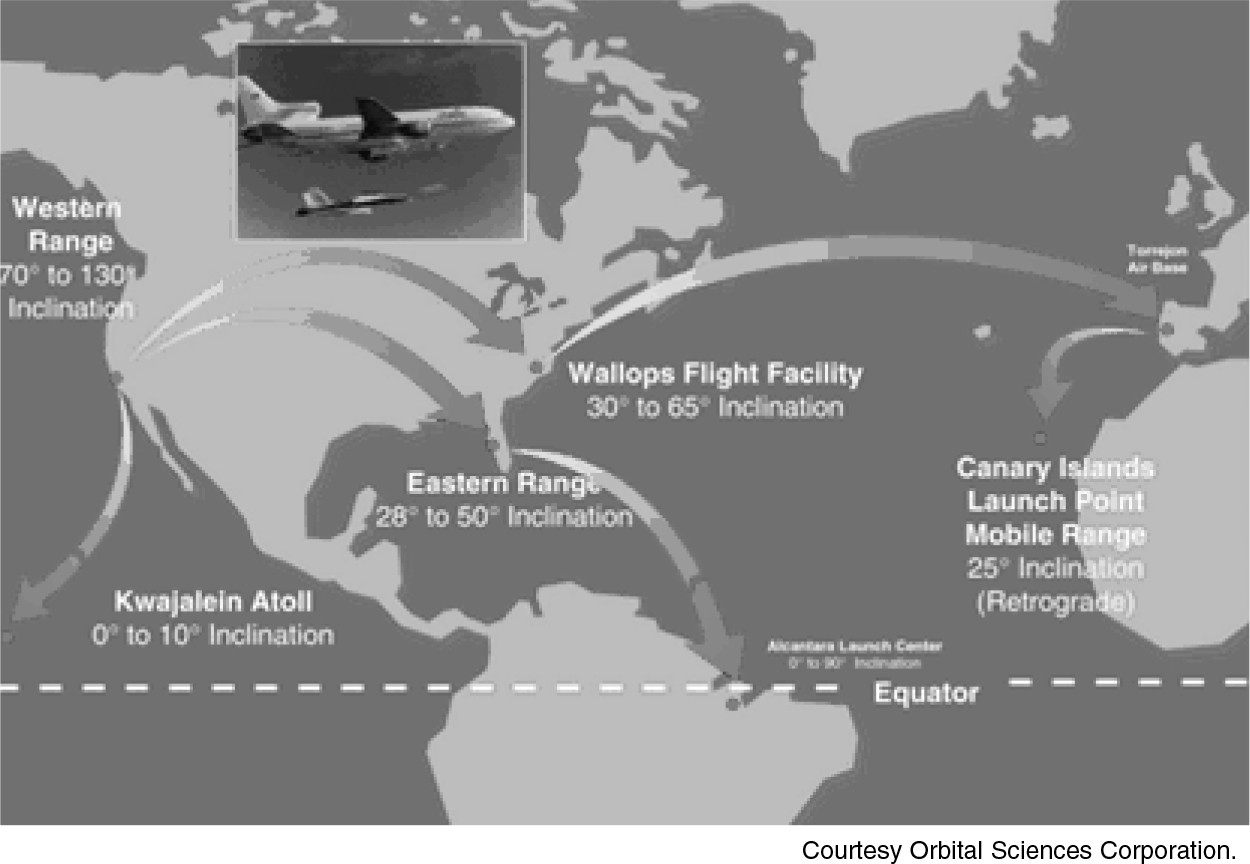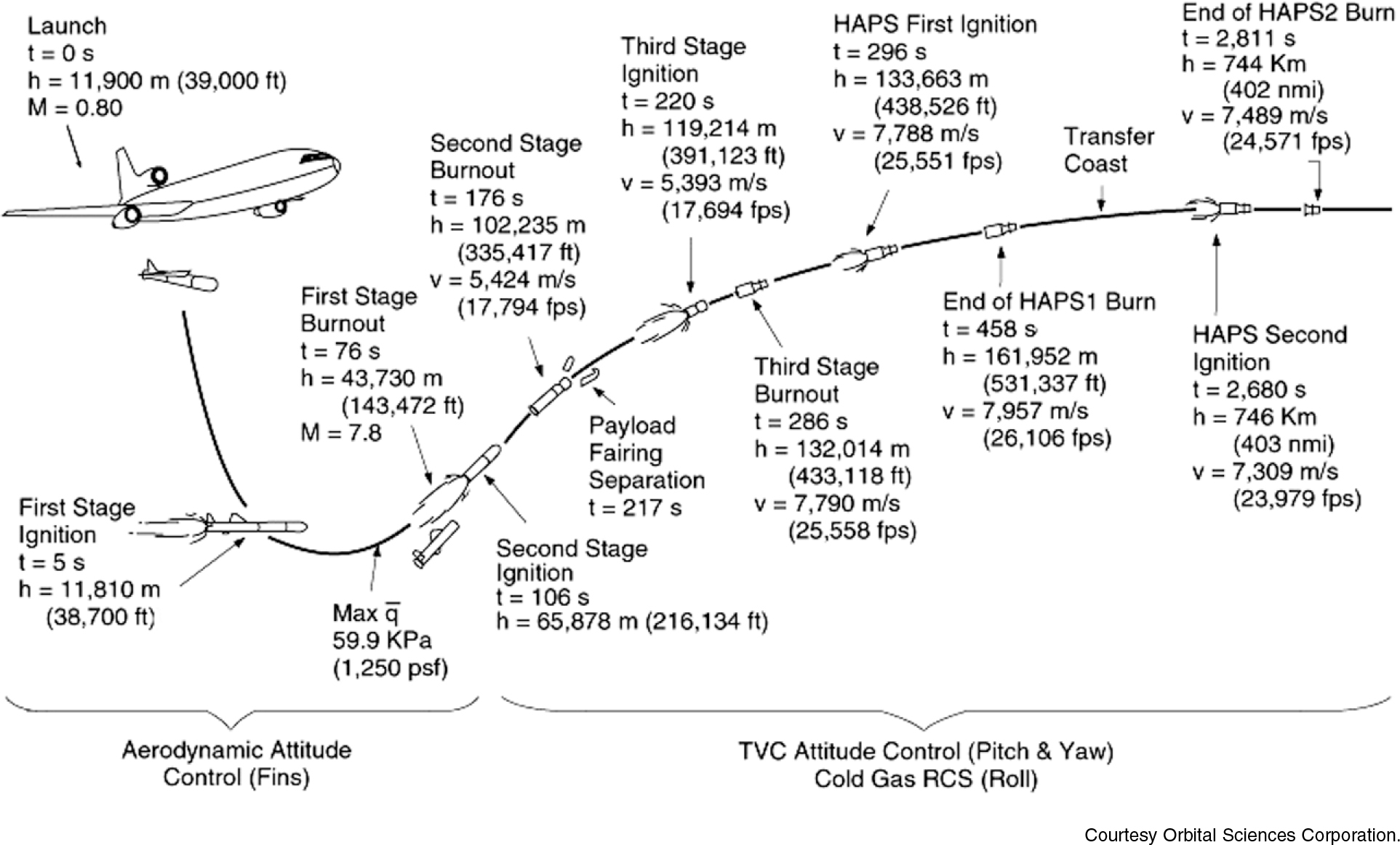Pegasus
Production and Launch Operations
Production
Orbital Sciences Corporation is the primary contractor for the Pegasus launch vehicle.
Subcontractor | Responsibility |
Alliant Techsystems | Solid motors and payload fairing |
Scaled Composites | Wing and fins |
Parker | TVC and RCS |
Litton | IMU |
Oettle Richler | Flight computer |
Launch Operations
Pegasus was designed to simplify and minimize field integration personnel, facilities, and equipment. The build up of Pegasus begins with the delivery of the SRM sections to the integration site at Vandenberg AFB, California. Motors are shipped in standard ordnance transportation vans (TARVANs) on custom-designed handling dollies. The motor sections remain on these handling dollies throughout the integration process, which eliminates the need for lifting motors in the field. Upon arrival, stages are removed from the TARVANs and placed on a custom designed multifunction assembly and integration trailer (AIT). The AIT has integral lifting jacks that allow it to be elevated to TARVAN bed height so the motor sections can be offloaded directly onto the AIT bed. The AIT is then lowered to floor level for motor offloading to one of the four vehicle integration rails. The avionics subsystem is delivered to the field completely integrated, acceptance-tested, and ready for integration with the third-stage motor. The wing, fins, and payload fairing are received with all thermal protection and instrumentation installed. Once the vehicle has been integrated and tested, the payload is mated and the fairing installed. The rocket is transferred back to the AIT, and the AIT is used to transport Pegasus to the carrier aircraft, elevate it, and align it for mating. The combined AIT and custom dolly system provides full six-degree-of-freedom movement capability for the finished vehicle. A portable air conditioning unit provides filtered, dehumidified air for the payload and avionics during transport. Once the rocket arrives at the airfield, a ground air conditioner provides thermally conditioned clean air until this function is transferred to the airborne air condition system on the carrier aircraft, which provides environmental control until drop.
No launch pad is required for Pegasus, only a runway capable of accommodating wide-body aircraft. Pegasus missions are launched from a modified L-1011 aircraft named Stargazer. Early government-sponsored launches were carried aloft by the NASA-owned B-52 aircraft that supported air drops of the X-15, X-24, X-38, and other experimental aircraft. Using an aircraft instead of a fixed launch complex reduces infrastructure costs. In addition, because launch is initiated well offshore, range safety requirements and associated concerns are reduced compared to typical launch sites.
Launch begins with the release of Pegasus from the carrier aircraft at approximately 11.9 km (39,000 ft) altitude and 0.8 Mach. First-stage ignition occurs 5 s after release from the carrier aircraft, after Pegasus has dropped approximately 90 m (300 ft).
Pegasus launch vehicles are assembled at VAFB, and the “standard mission” includes payload integration and launch from VAFB. In a “ferry mission” the spacecraft is integrated at VAFB, and then flown by the carrier aircraft to another launch site, such as CCAFS, for launch. In a “campaign mission” only the Pegasus is assembled at VAFB, and the spacecraft integration process is conducted at the alternate launch site. This gives Pegasus a significant degree of flexibility to adapt to customer needs and to reach a wider varietry of orbital inclinations. Launches have been conducted from four locations in the United States, plus the Canary Islands, and Kwajelein atoll in the Pacific. The Alcântara launch facility in Brazil is also available for future launches. If the selected launch location does not have tracking, control, and communications systems in place, deployable assets such as the NASA Wallops Mobile Range equipment can be used. Locations of Pegasus launch sites are shown below.
Launch Site

Examples of Pegasus-Compatible Launch Sites
Flight Sequence

Pegasus XL with HAPS
Pegasus Flight Sequence—Pegasus XL with HAPS to a 741-km (400-nmi) Circular, Polar Orbit with a 251-kg (554-lbm) Payload | ||
Event | Time, s | Altitude, km |
Launch | 0 | 11.9 |
First-stage ignition | 5 | 11.8 |
First-stage burnout | 76 | 43 |
Second-stage ignition | 106 | 66 |
Second-stage burnout | 176 | 102 |
Payload fairing separation | 217 | |
Third-stage ignition | 220 | 119 |
Third-stage burnout | 286 | 132 |
HAPS first ignition | 296 | 134 |
End of HAPS first burn | 458 | 162 |
HAPS second ignition | 2680 | 746 |
End of HAPS second burn | 2811 | 744 |